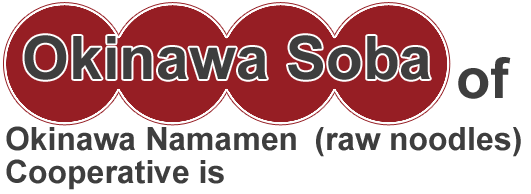

Okinawa Soba of Okinawa Namamen(raw noodles) Cooperative is truly authentic.
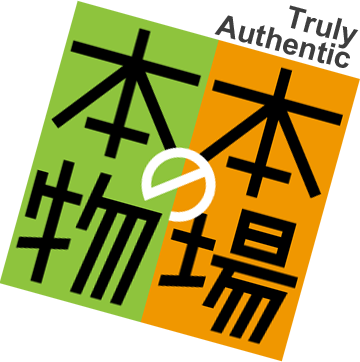

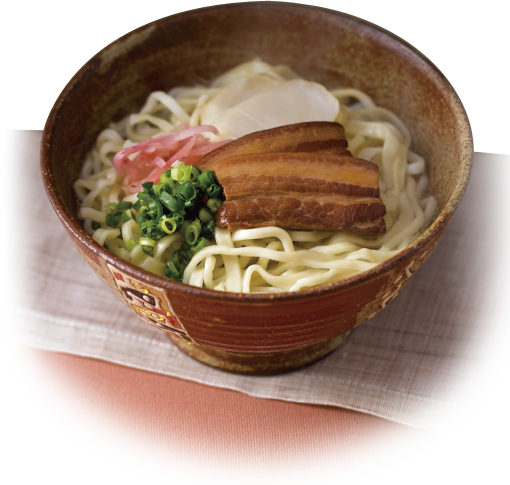


Genuine recipes,
traditionally used from all over Okinawa.
A true flavor created by using carefully selected ingredients from local farms and businesses.
We take pride in the ingredients and recipes and guarantee a “Truly Authentic” products.
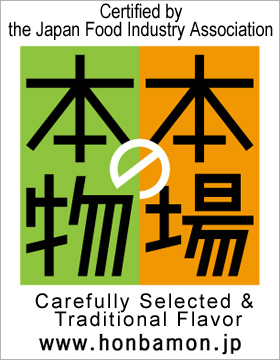
What is
“Truly Authentic”?
A labeling standard by the Japanese Food
Industry Association to protect and
cultivate an enriched
food culture in each area of Japan.
A mark given only to specially chosen food products.
■You can feel “Confidence”
The judging committee screens products based on very strict standards.
These questions are asked: “Is the origin of the name clear?”, “Is it possible to specify the district of production and does it match the true place of manufacture?”, “Can we see the history of tradition in the historical evidence”, “Does it establish the origin of the recipe and the ingredients are used in the food?”, “Is the quality of the products and standards of hygiene management clear?”, “Do they take an inspection regularly by a certificated third party institution?”, etc.
Certified “Truly Authentic” proves that the product has passed all of examinations. This is why we can feel “Confidence” in the product.
■We promise “Authentic”
“Truly Authentic” can be put on the product after passing through the judging committee. A third institution also checks if the product meets the standards of the certification.
Customers want to eat a local food without any concerns and know the manufacturers are particular about making traditional foods.
The label “Truly Authentic” is proof of a promise for “True Flavor” since the flavor and authenticity are inseparably connected.
■The Point at which Okinawa Soba was Certified.
1.The Characteristic of the Recipe
Okinawa Soba is made by putting salt water, salt, and Shikomi-mizu(contains baking soda, egg, salt, and water) into flour. Putting finishing oil into the noodles is the characteristic. Each recipe is slightly different depending on the tradition of that area.
2.The Characteristic of the Ingredients
Okinawa Soba isn’t made with buckwheat flour. It uses 100% jun-kyourikiko which has more protein than Japanese flour(hakurikiko) because it has ingredients which Okinawa Soba needs.
3.The Quality of Safety
One mill company makes the flour for Okinawa Soba and delivers to each Seimen(Noodle-making) factory. They manage hygiene according to the guidelines in their area and check the safety standards.

▲Featured in the magazine of
“Truly Authentic”
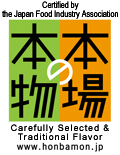
■The Site of “Truly Authentic”
Japan Food Industry examines products from all over Japan for the certification review about “Truly Authentic”. You can go to the site of “Truly Authentic” by Japan Food Industry to get the information about the details of the review and other certified products.
The Origin of Okinawa Soba
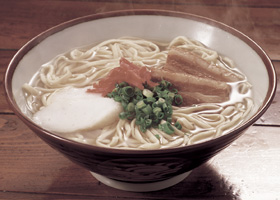
Okinawa Soba is native to Okinawa. The noodle is unique because it’s made with 100% flour. It’s considered a Chinese styled noodle because of the ingredients and recipe for making the noodles.
According to “Ryukyu Kouryu-shi(Ryukyu Exchange History)” in China, its’ origin is “Konayu(means soup-noodle in Chinese)” and it was presented at the memorial service for the King, forty nine days after he passed away in 1543.
It soon became a food for nobility. The rich people were able to eat it during Meiji period.
After World WarⅡ, it spread to ordinary people. It caused that various kinds of Okinawa Soba were made in many places to make money.
About Okinawa Soba
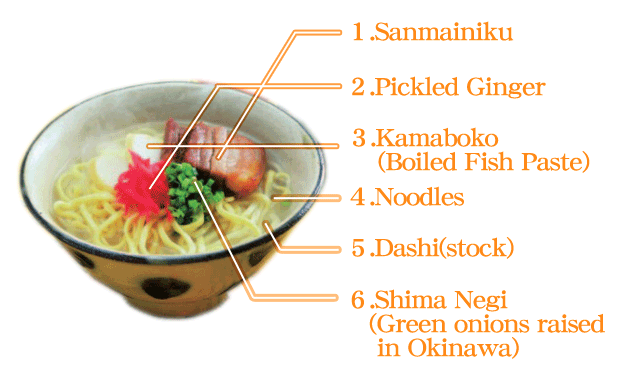
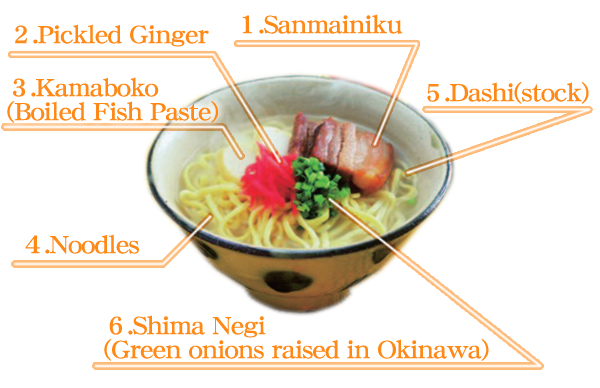
- 1.Sanmainiku
- Pork from the rib area. Cooked with soy sause and sugar. This must come with Okinawa Soba as one of toppings.
- 2.Pickled Ginger
- This gives a kick to the Dashi (stock) flavor from the pork bones. It is told that people loving Okinawa Soba are particular about red pickled ginger.
- 3.Kamaboko(Boiled Fish Paste)
- Okinawan Kamaboko is fried. There are many kinds of Kamaboko.
- 4.Noodles
- Okinawa Soba which isn’t made with buckwheat flour is chewy. The more you go north, the thicker the Soba is.
- 5.Dashi(stock)
- The base of dashi is pork and fish. In some areas, they put chicken, konbu(a kind of kelp), shiitake(a kind of mushroom) in the stock to give it a unique flavor. The flavor of the stock is very crucial.
- 6.Shima Negi(Green onions raised in Okinawa)
- Shima negi is necessary and used as a spice. Futo negi (thick green onions) are sometimes used as well. Some diners don’t chop the onions until right before it’s served to preserve it’s aroma.
The Characteristic of Each District
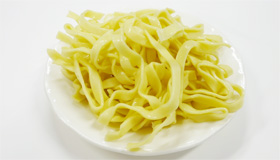
●Firm flat noodle
These are flat noodles shaped like a sash. People in the north of Okinawa prefer this type of noodle. It has a bit of chewy texture and is the most filling of the Okinawa Soba noodles.
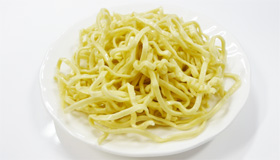
●Middle Sized Wavy Noodles
These noodles are wavy. People generally love this type of noodle because the Soba soup clings to the noodle better. People in Naha and southern areas of Okinawa prefer to eat this type of noodle. If you can’t decide which type of noodle to eat, try this noodle.
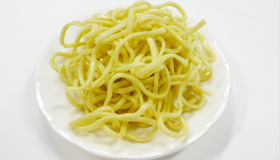
●Thin Round Noodles
People on Miyako, another island of Okinawa, prefer to eat this type of noodle. This is firmer than the other noodles because of the shape. This noodle doesn’t take much time to Yudooshi(dip into boiling water for a moment before put into the soup). The noodles go down smoothly as you eat them.
The Characteristic Production Process
Each district has its own unique characteristic used in the production process. Okinawa Soba tastes so good because it follows these processes perfectly! See the production process(presented by Mitukura Shokuhin).
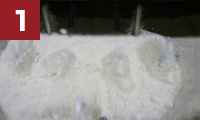
Put salt into the flour of the Okinawa Soba and Kanko then knead it. As it becomes the dough of Okinawa Soba it will turn a yellowish color.
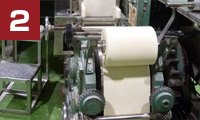
Flatten the dough into a long belt like strip, making 2 layers. This operation is called “Fukugou”. Compressing the dual layers releases air from the dough which helps the dough tighten. Repeat this several more times.
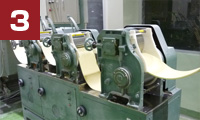
Then, compress and flatten the dough to the size of Soba noodles. Cut it the width of the Soba noodles represented in each district.
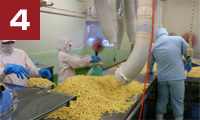
The noodles are then made wavy by hand, a traditional process called “Temomi” (this work is skipped in the Miyako and Yaeyama areas). Next, “Yudooshi” and “Aburamabushi(putting finishing oil over Soba noodles) are done to prevent the noodles from sticking
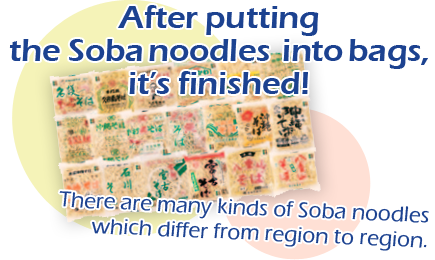
This is the way how to make Soba noodles from each district.
Each district has its own traditional flavor of soup and noodles which are kept
and inherited by the people there.
Looking for those different flavors is part of the fun in eating Okinawa Soba.
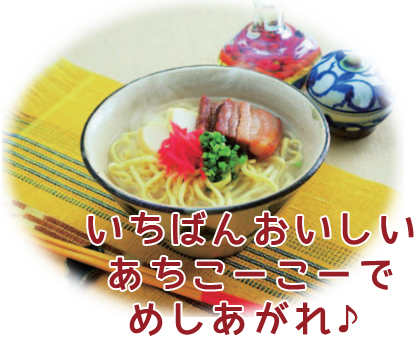
About Okinawa Namanen Cooperative
Okinawa Namamen(raw noodles) Cooperative is a local business group related to Okinawa Soba manufacture. The purpose of this group is to respect the traditional and historical flavor and recipe of “Okinawa Soba” which is a food of the Okinawa prefecture, to have future success, and to expand the business from Okinawa to the world with steady growth.
■About Approval of the Name “Okinawa Soba”
The Fair Trade Commission gave us a warning because of a TOS violation in 1976. They said that we couldn’t use the name “Soba” because Okinawa Soba isn’t made with any buckwheat flour.
However, Okinawan people already called it “Suba(Soba)” and it was a recognized tradition. Knowing this, Kenichi Tsuchigoe, the chairman of Okinawa Namamen Cooperative at that time, began working to get approval for the name “Okinawa Soba”
As a result, the name “Okinawa Soba” was approved on the basis of “the fair competition code about label raw noodles” on Oct. 17 in 1978. It made it possible to participate in the market of mainland Japan. (Since then, October 17th has become “the day of Okinawa Soba”.)
Many people worked hard even though their stories aren’t told. We can call our soba, “Okinawa Soba”, thanks to them.

■The Main Activity


●Okinawa Soba’s Charity Campaign
We have a “Make handmade Okinawa Soba” class for schools because we want the children who are the future of Okinawa to know the flavor and process of making Okinawa Soba. We also receive invitations to bring this class to various local groups. These activities that let us spread Okinawa Soba throughout Japan also help us build a relationship with our communities.
Also, since 2013, we’ve had a class for the “Monozukuri Taiken(Experience of Handmade)” event which is as part of the “Improvement Ability of the Youth and Human Resources Development Support Project” presented by the Okinawa Vocational Ability Development Association.
We have various charity campaigns to spread Okinawa Soba. One of them is “A Year-end Charity”. We delivered Okinawa Soba to the Okinawa Prefectural Senior Welfare Institute from 1988 to 2002 through the Okinawa Prefectural Social Welfare Council.
Since 2003, we’ve donated Okinawa Soba on Nov. 11th, the Day of Noodles, which was enacted by the National Seimen United Cooperative.
Since 2008, we’ve donated to various organizations who aid less fortunate children or people with disabilities.
■The Corporation Lists of the Cooperative
The Namamen Cooperative consists of 20 offices in mainland Okinawa and islands of Okinawa. Each corporation received the certification of “Truly Authentic”.
Sankakuya Seimensho Co. Ltd.(Nago City), Kudaka Seimensho(Uruma City), Maruishi Seimen(Uruma City), Miyagi Seimensho(Okinawa City), Chuubu Seimensho(Okinawa City), Chinen Seimensho(Okinawa City), Sunabe Shokuhin(Chatan Chou), Futenma Seimensho(Ginowan City), San Shokuhin Co. Ltd./Sun Foods Co. Ltd.(Itoman City), Aiwishu Co. Ltd.(Okinawa City), Mitukura Shokuhin Co. Ltd(Nishihara Chou), Nishizaki Seimensho(Itoman City), Kanton Shokuhin(Naha City), Isa Seimensho(Naha City), Kumejimasoba Kakousho(Kumejima Chou), Koja Seimensho(Miyakojima City), Hisamatsu Seimensho(Miyakojima City), Kinjyo Seimensho(Ishigaki City), Nikawadori Shokuhin(Ishigaki City)

